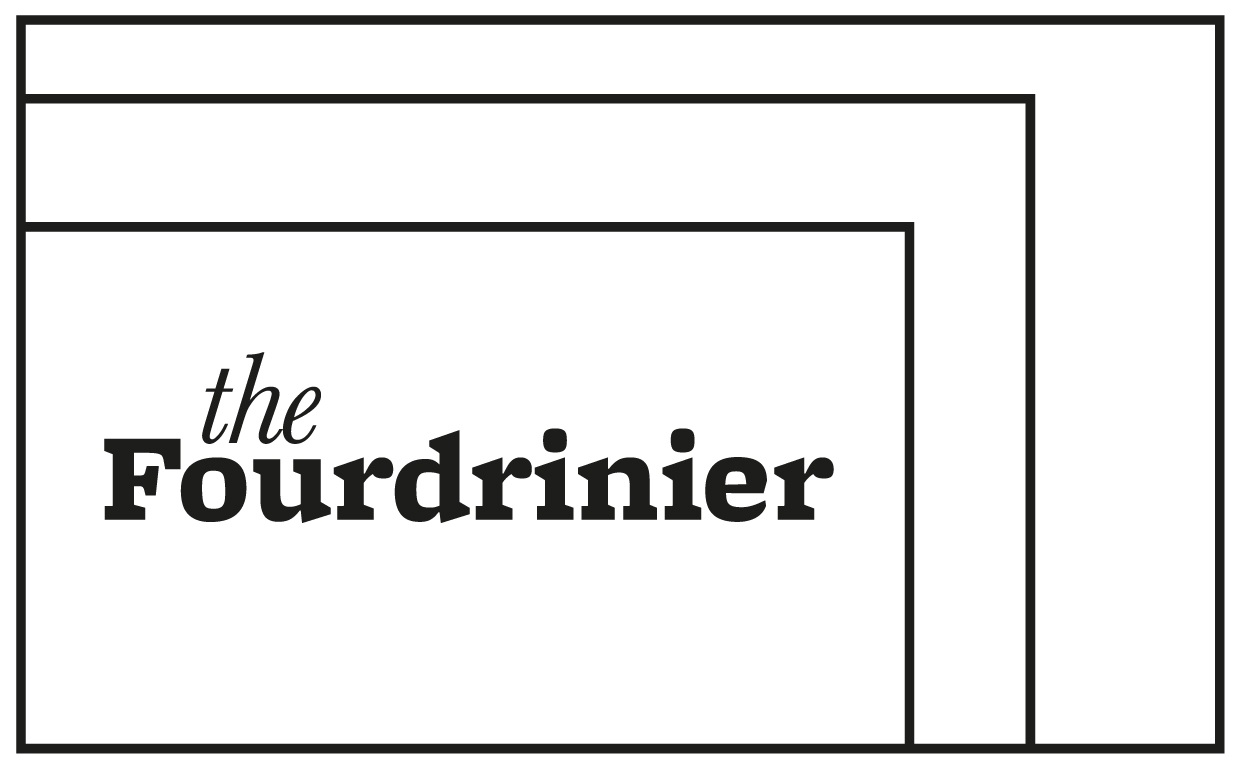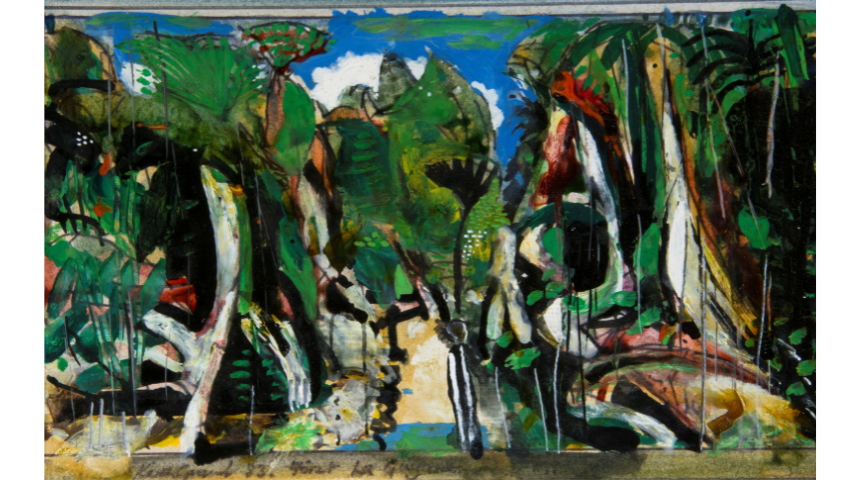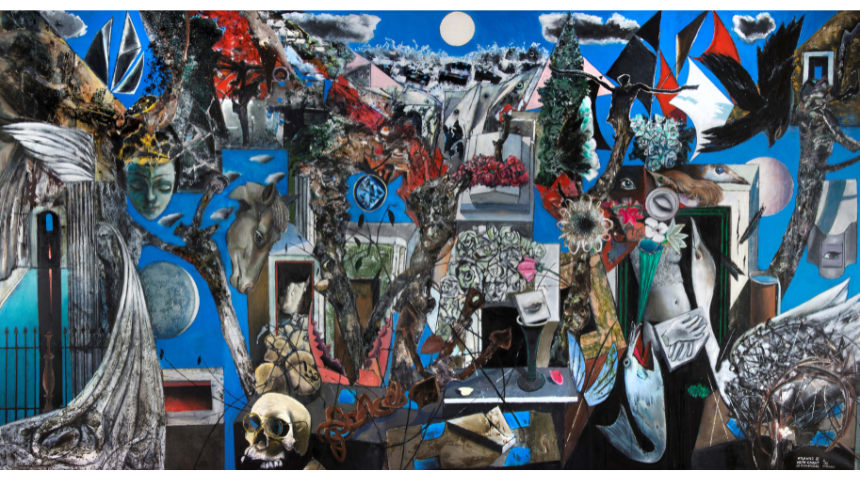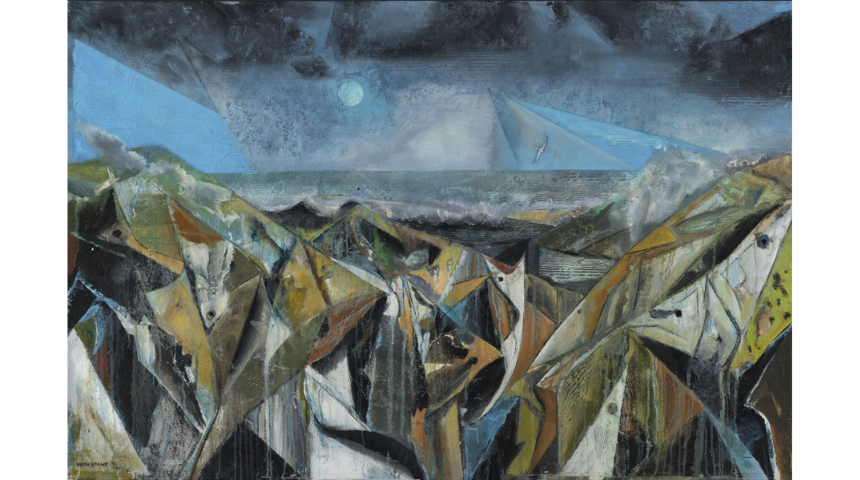REVIEW Feb 2025 ‘Elemental Nature: Keith Grant’ at The Atkinson
Jo Manby
Keith Grant Volcanic Landscape, Iceland (1966) oil on canvas. On loan from David Game College. Photo courtesy of the Chris Beetles Gallery
Liverpool-born Keith Grant’s artistic career spans the longitude of the globe, cutting a pathway through the Arctic and Antarctic via Africa, Europe and the tropics. Visitors to The Atkinson can soak up paintings spanning an almost 80-year period: simmering among proliferations of trees and plants in the rainforest, dazzling in front of Icelandic volcanoes, and staring out the particles of the cosmos in paintings of hyperreal serenity and boreal stillness. Guest curator Andrew Lambirth has gathered together a multitude of key works from all the main phases of Grant’s career, and the exhibition, reviewed here by the Fourdrinier editor Jo Manby, is complemented by the excellent monograph, ‘Keith Grant’ by Dr Judith LeGrove, published by Lund Humphries and available in The Atkinson shop. The exhibition is free to visit until 15 March 2025.
View from the Bedroom Window (c1953) is one of the earliest surviving of Grant’s oil paintings. The young painter immediately confronts a green and black vortex of foliage and branches head on, dispensing with the need to contextualise with window frames, although the view is from an upstairs room. There is more interest in the gateposts across the street for the visual rhyme they set up with those at the front of the picture, as pictorial elements, than as part of any narrative. Street life is incidental. All focus is on an irradiation of leaves and bark issuing from a central black core.
Keith Grant View from the Bedroom Window (c1953) oil on board 63.5 x 89cm The Atkinson, Southport. Photo © The Atkinson, Southport
Hung in his first exhibition, at Bootle Art Gallery, this work was purchased for Sefton Council collection before ownership was transferred to The Atkinson in the 1970s. Even aged 23, he is seized by a desire to record the complexity and concentration of the natural world. Grant was born in Liverpool in 1930, one of twins. Despite a slightly difficult upbringing, his aptitude and love for artistic expression soon emerged and fortunately he was able to pursue it throughout his life, starting very young with the help of a kindly primary school teacher and out of school watercolour lessons aged 15 or 16 with the three Isaacs sisters over at Litherland. He studied at Bootle College of Art, Liverpool, then Kilburn Technical College and Willesden School of Art 1952-55 before graduating from the Royal College of Art (RCA), London in 1958, where he won a silver medal for mural painting.
In 1948-50 he was drafted into National Service, and served in the RAF. He was wayward and bold, responding to a challenge when he criticized the art on display in the canteen by swiftly executing two huge panels which he was ordered by the Warrant Officer to complete by 8am the following morning. He painted View from the Bedroom Window after travelling in France in 1953, and you can see the influence of Paul Cézanne, whom he admired. He was also influenced by many other artists, such as John Minton, Ruskin Spear and Carel Weight who taught him at the RCA. There, students were encouraged to make a living in ways other than teaching, including murals, a genre in which Grant became proficient.
In 1954 he participated in an architectural dig at Verulamium, a Roman town near St Albans. Through the director of the Verulamium Museum, John Lunn, he received a commission to paint six large mural panels for the museum. At this time, he also painted Landscape, Verulamium and Roman Wall (1958), on show at The Atkinson. It’s possible to read his affinity with the topology of the earth as he mines the landscape for deeper meaning, wanting to get into it, walk around in it, note its interesting salient elements, work it. Grant’s biographer Dr Judith LeGrove notes that in an earlier painting, Marinescape (1953-4), featuring an imaginary structure of a boat, ‘Grant remembers almost “building” it from wood as he painted’. (1) His contemporary influences begin to come to the fore: Patrick Heron, Peter Lanyon, Ivon Hitchens – and particularly, in Landscape, Verulamium and Roman Wall, we can see analogies with Paul Nash’s paintings of the mystical wooded vistas of South Oxfordshire, specifically the Wittenham Clumps.
Keith Grant Beyond Silence (1989) oil on canvas 68.5 x 118cm Private Collection. Photo: Richard Gray
In 1957, Grant made his first of many trips to Norway, spending two weeks in the western fjords, walking, taking photographs and sketching. He made his second visit in 1960-61, and studied Edvard Munch’s murals in Oslo. He was absorbing Abstract Expressionism (Rothko, Pollock, de Kooning, Motherwell, Kline), providing direction to the inspiration he encountered in ‘glaciers, icebergs, mountains, avalanches, auroras and nightless days: “a ground relatively unexplored” on which to base a lifetime’s work.’ (2) This visit was funded by a Norwegian government scholarship via the British Council. Grant sailed to Norway with no previous experience, was stranded on Dogger Bank for a week and drifted for three days on high seas. Svolvaer Motif (1962) is the earliest Norwegian subject in The Atkinson exhibition, an edifice of grey and black icy rocks, a single white bird, which became a recurrent motif. LeGrove notes the development of his ‘dark identification of self with landscape’ (3).
Composed of tightly packed strips of off-white, scuffled and richly coloured paint – purple black, rust red, slate blue, mauve, moss green – the composition of Volcanic Landscape, Iceland (1966) corrugates the bottom half of the canvas and then pulls together in an upward diagonal thrust towards the upper left of centre. A half circle gapes, doubling as a shrieking bird and the mouth of the volcano, which emits a jet of ochre fire and a cloud of white smoke, dynamically offset.
While we can trace emergent Cubist forms and palette, reminiscent of the vertical compositional sweep of Picasso’s now ubiquitous Demoiselles d’Avignon (1907), and Grant has spent time in the Mediterranean part of Europe, his life and work have been dominated by the pull of the north, its unrelenting power and savagery. His fascination is palpable in his journal entries as he describes lava fields south east of Reykjavik:
‘…the flow of lava undulating like the sea… caves appeared under vaults of contorted and twisted lava – red, blue and orange pigments flowed from great wounds on the sides of old volcanoes… In this scene was the complete and most beautiful negation of landscape. A beauty incomprehensible without the taste of the lava-dust and the stench of rotting cod and the elixir of the salt-laden air.’ (4)
LeGrove again quotes from Grant astonished by his experiences of sailing close to the volcanic island of Surtsey: ‘…to honour the gravity of this inspiration would require an expression approaching that of “the great religious pictures… a pieta of our world.”’ (5)
Keith Grant Reflections in a Lake, Night (1969) oil on canvas. On loan from David Game College. Photo courtesy of the Chris Beetles Gallery
Flanked by pale rocks and punctuated by slender birches, the main focus of Reflections in a Lake, Night (1969) is on fiery orange interlocking shapes furrowed by thick black ruts. A face with frowning brow and glinting golden eyes seems to peer out of the landmass and water, evoking a waking green man or Norse god caught fast in their autumnal dwelling.
Writing from his studio in Camden in Spring 1967, Grant recalled recently photographing the sun reflected in a lake: ”the pool became another medium in which were suspended strange light-bearing vessels, brilliant in a dark solution.” (6)
Grant developed an interest in reflections in water, in the effects of doubling, refracting, the geometrical potentiality when composing. The picture plane was the site of his constant attempt to ‘contain’ nature, mark it down, specify its wildness. Elements of his work recall Post Impressionism. In his talk at The Atkinson with LeGrove, he spoke of the narcissism of the earth/nature looking at itself. Grant seems to render the world as if possessed by its own terrifying beauty.
Maritime Polar (1973) was originally created as a huge panorama of 24 canvases in total. Grant also wrote a Beckettian four act play of same title at what could be seen as this mid-point in his career. The cyclorama charts the 24 hours of the day, and was originally displayed on screens set in a circle. The four-part Maritime Polar: Snow Drift, Clear Sky (1973) which belongs to Touchstones Rochdale Art Gallery collection, on loan to The Atkinson, functions well as a grouping of its own. Concepts of shifting time and journeying through landscapes are key to the structure and content of the work.
Grant’s exhibition ‘The Way to Cold Mountain’ (1976) was titled after a place in the poetry of Han-shan, a Tang Dynasty Chinese Buddhist and Taoist figure, and popularised by Jack Kerouac in his novel ‘The Dharma Bums’ (1958). LeGrove suggests the white peak of Snow Drift, Clear Sky could be ‘a symbol for Cold Mountain’. (7) During January 1973, Grant had heard a volcano was erupting on the Island of Heimaey and flew to Iceland the next day to observe it, making six visits that year. This led to the exhibition ‘The Volcano in The North’ at Portsmouth Museum and Art Gallery the following year, and to the creation of Maritime Polar.
The Blind Moon (1978) painted the following year is typical of his fascination with the cosmic. As a child he had been enthralled, as he described in his talk at The Atkinson, with the expansive horizon and the particular layered cloud formations observed in his home town of Bootle, Merseyside. An early ambition, he relates, was to be a weather forecaster – he was fixated on finding out where clouds came from. This painting depicts one of two total lunar eclipses in March 1978 Grant observed from Svolvaer, on a three month visit to Norway to prepare for an exhibition. He kept a visual and written journal, as had become habitual for him, this one entitled ‘The Norwegian Journey: Letters to Myself from the Corridors of the North’. The Blind Moon features a night sky saturated in inky blue green darkness, the eclipse like a faint circle of frost on indigo glass.
Keith Grant Foret Le Guyane (1983) acrylic on board. On loan from David Game College. Photo courtesy of the Chris Beetles Gallery
Grant also travelled to the tropics and the desert, including Kourou, French Guiana in 1982 to document the first commercial launch of the rocket Ariane with a joint commission from the Department of Science, Information and Technology, British Aerospace and Logica plc. LeGrove quotes from his journal of the time, of which little remains now, his description of the ‘dark, inexpressibly sad, silent interior’ of the jungle. (8)
In Foret Le Guyane (1983), manipulating a palette predominating in greens, black, white and blue accentuated with flashes of scarlet, Grant succeeds in communicating the suffocating crush of tropical vegetation. Brushstrokes appear raw, sign like and unblended, paint drips down the canvas alongside vertical splices of pale grey, as if he has dragged the wooden tip of the paintbrush down the surface, scoring into the wet paint in an urgent gesture.
He was oppressively aware of the horror of the Devil’s Island French penal colony, and a string of other prisons around Kourou and Sinnamary dating back to the time of the French Revolution of 1792, still haunting the forests. LeGrove notes a recollection of his dating to 2020, when he described an overwhelming abundance here, precipitating loss of personal identity, as opposed to the north, where he was an observer looking out but simultaneously deep inside himself.
A counterpoint to Foret Le Guyane, Beyond Silence (1989) has an innate sense of stillness. There is the sense of the solitude of the artist at night gazing into the utter darkness, mind absolutely focused but transcending the visual to plumb more profound spiritual depths. A starless sky surmounts an illuminated paring of land, a fine gilded strip of a horizon eked out almost to zero at either side of the canvas. A lone and worryingly small ice floe, at once adrift in this immensity, and concealing a vast iceberg below, of which it is only the very tip.
Keith Grant Atlantis III: Le cimetière marin (2015) oil on canvas 141 x 261cm. Collection of the artist. Photo courtesy of the Chris Beetles Gallery
The celebration of myth in Atlantis III: Le cimetière marin (2015) is based on impressions gleaned from a visit to the French symbolist poet Paul Valéry’s birthplace and coastal burial place at Sète in the South of France, a cemetery of jutting bright stone mausoleums and of coronets of red roses dried in the sun to the deep maroon of the stigmata on statues of Christ. It refers to Valéry’s poem ‘Le Cimetière Marin’ (‘The Graveyard by the Sea’), in which the poet intones ‘long vistas of celestial calm’ and ‘the manifold diamond of the elusive foam’. (9) Grant read the poem in both French and English and, combining this close reading with his field research, achieved a synthesis of these elements through the lens of his own artistic invention and vocabulary.
The result is a buoyant, glittering schematic frieze-like tank of symbols: Leda and her swan; Minerva’s winged head; horses, eyes, lips, hands, disembodied and surreal; iron railings, a marble column, angelic stone drapery; human skulls, flowers, crucifixes, cut stones, sails and the flood of azure sky-sea all this cemetery flotsam floats around in. The palette is bold, primary and unapologetic: red, blue, black and white.
Keith Grant Seadrift by Moonfleet (2020) oil on linen 100 x 150cm Collection of the artist Photo: Douglas Atfield
Returning to earlier themes in Seadrift by Moonfleet (2020), literary references intersect as Grant’s brush splices together hybrids of bird/fish, cloud/wave and sky/water. Bird like forms strain to emerge from waves of interlocking rock or ice while a solitary gull arcs away from the full moon. Using grattage like Max Ernst, also a lesson taught him by his primary school art teacher to temper his wildernesses with a wash of pale colour, Seadrift by Moonfleet is wild but unified, cohesive. It makes pictorial sense. Walt Whitman’s poem ‘Sea Drift’ (1891-2) is an inspiration here, which tells of a seabird whose mate fails to return, and an adventure story ‘Moonfleet’ (1898) by J Meade Falkner about smuggling on the Dorset Coast.
From the Old Bridge, Grez-sur-Loing, France (2023) is a painting of mystical serenity and calmness tainted by premonition or warning. Fixated on geometry, an isosceles shaped cypress rears out of river mist in the distance and is reflected so four triangles intersect: a green sward, the river mist, the real cypress and its mirror image. The cypress reappears as an equilateral in the foreground, to the left, hovering what would be half a metre or so above the pristine lawn of the riverbank, doubled by a black triangle on the water. And our entry point to the painting: a further, central charcoal grey triangle set like the prow of a ship on which we are the unseen figurehead, gliding into the beguiling scene before us.
This pristine painting falls between the surreal and the hyperreal. It has the crystalline focus and the metaphysical moodiness of a de Chirico. As a late work, it realises all the elements of Grant’s long career – earth, sky, mirroring water and fire are all present. Above all, it is compelling: we, the viewer, are invited in.
Grant settled on Norway as his home from 1996, even though he retains close ties to Liverpool, for the solitude and focus he finds living and working in the northern countries, still practising as an artist aged 95. Some works seem fraught with anguish and despair. As in Foret Le Guyane, the impact of human suffering is never lost on him. He has painted works of political commentary and protest, for example organising exhibitions to fundraise for Medical Aid for Vietnam. Then there are other moments when the expansiveness of nature rather than overwhelming, is gathered in, as in Seadrift by Moonfleet. Whichever direction he is going in, the pictorial articulation he delivers is always engaging and compelling. Whether in an utterance of calm and solitude, frenetic disruption, or the sheer beauty of the north’s ‘divine geometry’, Grant’s work is calling you.
Keith Grant From the Old Bridge, Grez-sur-Loing, France (2023) oil on linen 80 x 100cm Collection of the artist. Photo: Kjell Bitustøyl
Footnotes
(1) Judith LeGrove, ‘Keith Grant’ (Lund Humphries, 2023) p19.
(2) Grant, Journals, 23 November 1964, Fitzwilliam, GRANT 2/1, cited in ‘Keith Grant’, Judith LeGrove (Lund Humphries, 2023) p33.
(3) Judith LeGrove, ‘Keith Grant’ (Lund Humphries, 2023) p35.
(4) Grant, Journals, 14 May 1965, Fitzwilliam, GRANT 2/1, cited in ‘Keith Grant’, Judith LeGrove (Lund Humphries, 2023) p38.
(5) ibid.
(6) 29 May 1967, Fitzwilliam, GRANT 2/3, cited in ‘Keith Grant’, Judith LeGrove (Lund Humphries, 2023) p45.
(7) Judith LeGrove, ‘Keith Grant’ (Lund Humphries, 2023) p51.
(8) Grant, Journals, 4 September 1982, pasted into Journals, July – August 1983. Fitzwilliam, GRANT 2/15, cited in ‘Keith Grant’, Judith LeGrove (Lund Humphries, 2023) p67.
(9) Paul Valéry, ‘Le Cimetière Marin’ published in ‘Charmes ou poèmes’, 1922, translated into English at babelmatrix.org
Preview the exhibition virtually here: https://www.theatkinson.co.uk/exhibition/keith-grant/
This review is supported by The Atkinson








